Bill Peckmann &Comic Art &Illustration 15 Jan 2011 09:01 am
Sad Sack – 3
- I’ve been somewhat surprised by the number of people who came out of the woodwork to tell me that they liked seeing these Sad Sack posts. Most of those who commented to me are middle aged; I assume they remember the strip fondly or the War or something, but they liked what they saw. I hope younger fans can still enjoy the interesting pen and ink lines if not the jokes. There were no comments on the posts but the emails and casual comments in conversation leads me to believe they’ve been popular posts.
So, here’s part 3. This was all started by Bill Peckmann who sent me scans from a book he’s owned. I was interested enough to track down the book and scanned them, myself. Thanks to Bill for reminding me about George Baker’s soldier.
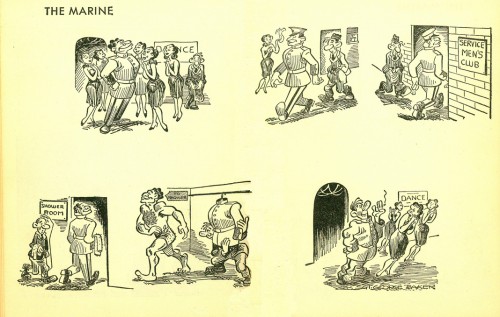 1
1
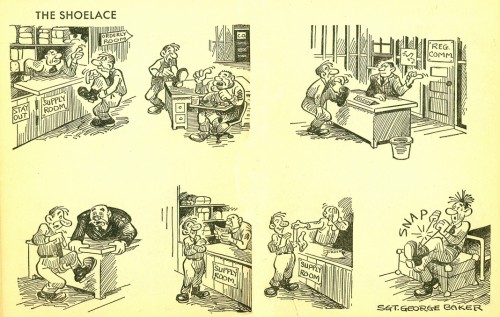
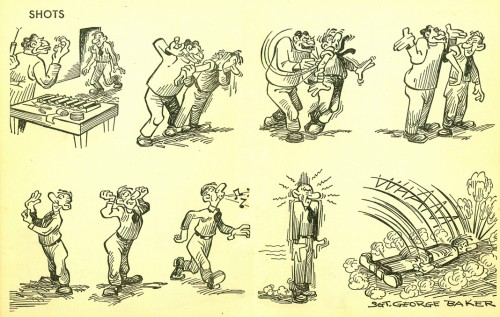
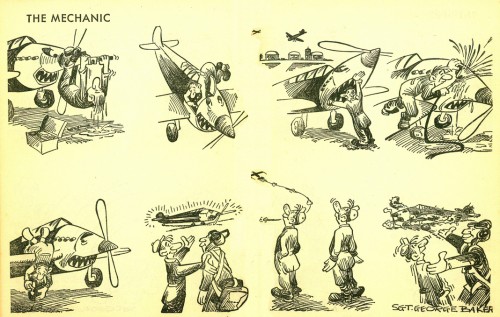
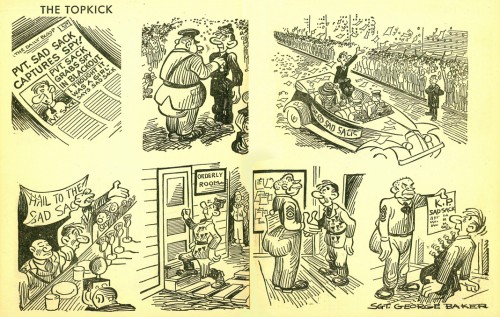
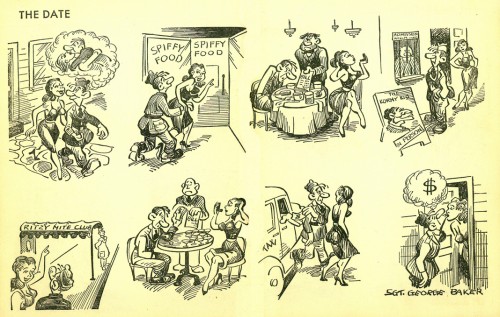
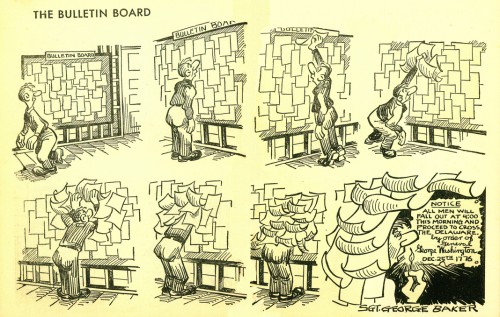
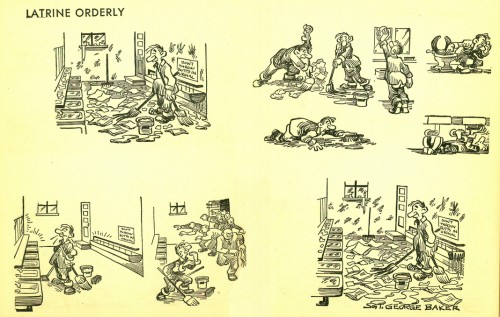
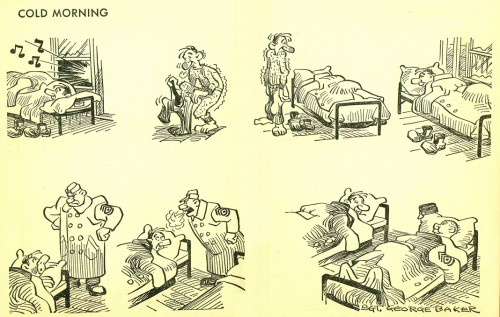
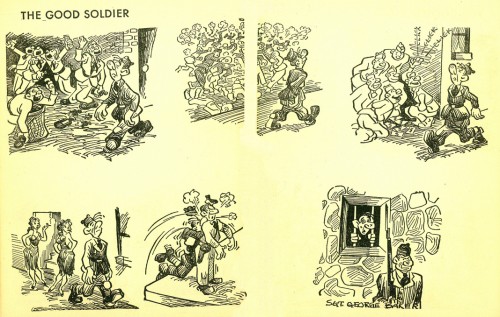
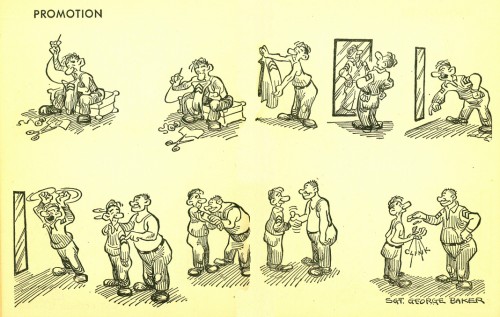
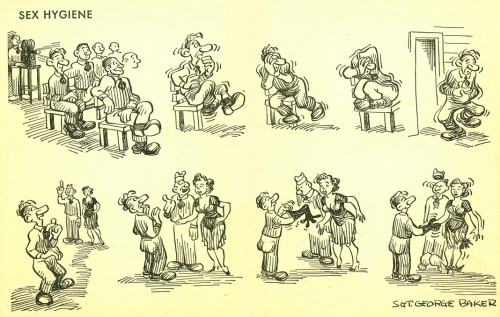
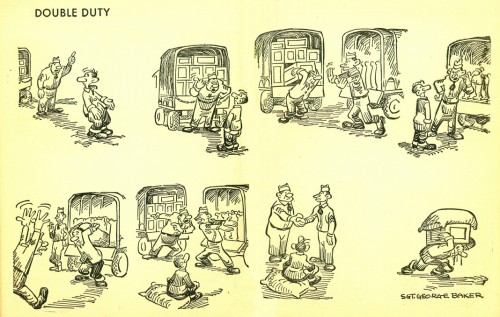
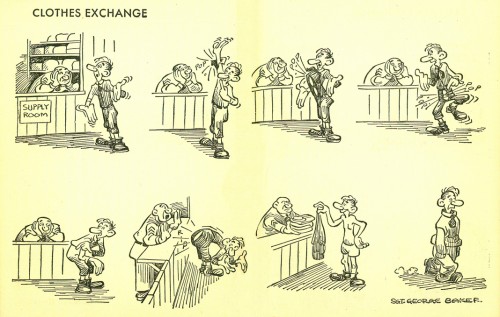
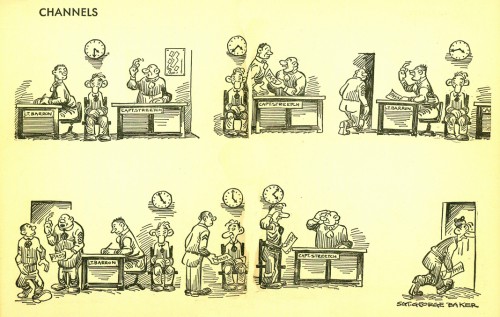

on 16 Jan 2011 at 6:33 am 1.The Gee said …
Maybe the comments that are being made on the “Sad Sack” posts are disappearing. I swear there was one here earlier.
As it goes, Baker’s comic was a good one. There is something about what that generation who came of age during WWII had that on one hand made their contributions to cartoons richer by being more grounded, for the lack of a better way of expressing it. Perhaps I’m being limited in my thinking, but, there were not a lot of fabulism that came out of that generation, unlike the works of Winsor McKay and his generation.
Then on the other hand, the approaches they used for drawing was quite different. There was a different to cartooning for print. The ones who worked in animation briefly or for a while developed different approaches and used space differently ( Walt Kelly, funny animal comics). Then there were editorial cartoonists who drew with grease pencils for their finished art (Fitzgerald, Herblock).
There could probably be a lot written about it in a more succinct manner than I can or will here but, with at least cartooning, there was something different that developed during that generation and the Korean War in-between generation.
I know the addition of color supplementals changed strip cartooning a lot in the 30s (if I recall correctly) but I’m wondering if movies and a decent sized collection of first generation American cartoon art didn’t influence those born in the Depression and later in an odd way to bring about that WWII/post-WWII shift.
Again, if I’m forgetting something/someone who did come from illustration stock, did elaborate strips and who dealt with fantastic, fabulist stuff let me know. As far as I can think, the science fiction comics/cartoons come closest to a heavy reliance on invention. Other than those, things seemed more grounded, true-to-life.
on 16 Jan 2011 at 6:38 am 2.The Gee said …
After reading that I should clarify:
By Grounded and Truer-to-Life….as far as cartoons go. And, I’m thinking more in terms of print than in animation. Though, I’m wondering what and when a shift occurred there prior to television changing production and types of cartoons that were made.
on 16 Jan 2011 at 8:51 am 3.Michael said …
I believe you’re right. Everything did become more reality based. I think the War hads something to do with it, but it was also, probably, the “Art” being done at the time. Picasso and Matisse had had their effect, and the Expressionists had just formed. People were more in the mood for Steve Canyon and Dondi. Comic strips like Blondie and Bringing Up Father played off of real situations rather than fantasy. This was the period when I grew up. It came as a big surprise when I did find the “Fantastic” cartoons of McCay or Feininger.
on 16 Jan 2011 at 5:02 pm 4.The Gee said …
I haven’t re-read what I wrote but it should be said that I don’t mind the changes that happened.
The changes in fine art are a good point. I guess I tend to consider how cartoons influenced fine art rather than the other way around or as a contemporary cultural marker of some sort.
Action strips and adventure comics….might that be in part because of pulp fiction (cheap dime store books), movie serials and radio dramas? Those things I haven’t had a much of a chance to experience other than briefly. But, it would seem like those would have been influential to imaginations and the eventual output, too.
The missing fantastic stuff though…you’d think with “The Wizard of Oz” coming out when it did and the fact that people sought out and took in a lot of escapist entertainment would have allowed for some amazing absurdity or Out There stuff.
Obviously, things changed a generation after the 40s/early 50s….
Though…..before I Submit this, I am forgetting someone.
Dr. Suess. His career spanned from the 30s on. He obviously did a lot of animation work in the 40s. But, he continued kicking it with allegories and absurdity. In fact, he was a strong advocate of Whimsy. That still strikes me as a beautiful thing to push for and to wish for.
Maybe childrens book writer illustrators were a minor exception to the trend? Though pop psychology did begin to rear its head in those quarters, too. ha ha.
I don’t mean to write too much about this or to seem like I’m over-inflating a cheap balloon, the subject or myself. It is I love the whole lineage of American cartooning and the influences and changes continue to fascinate me. Heck, it is better to write about the good things than to take pop shots at the bad. (I write, rationalizing my wordiness. ha ha)
on 16 Jan 2011 at 5:23 pm 5.The Gee said …
Briefly, about the Sad Sack examples.
Everything looks so bottom-heavy in the “panels.” While it seems like everything is well-rooted on the ground and that Baker knew was consistent in the plane he drew on, the line work and the shapes help give it weight, if you will.
In staring too closely, and for too long, two things stand out:
1) he likes drawing butts;
2) he uses a lot of vertical hatching/lines, which probably helps much with the illusion of weight, along with the other visual elements.
I know there were Sad Sack comics and I doubt Baker himself drew those but does anyone know off-hand if he worked in color? He doesn’t strike me as a painter but I’ve been hit before for guessing incorrectly…
on 14 Oct 2019 at 3:58 am 6.spdzyIXvWrkgf said …
TysNVhCaYI